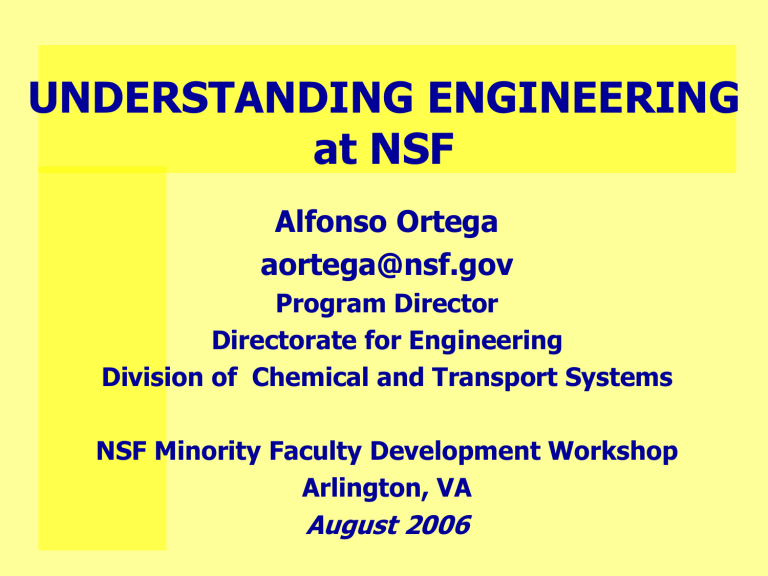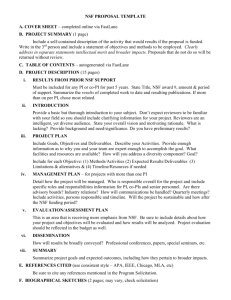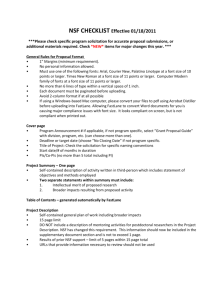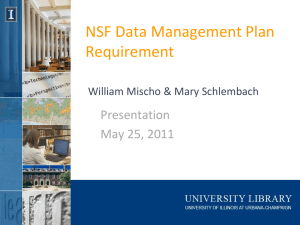Understanding Engineering at NSF

UNDERSTANDING ENGINEERING at NSF
Alfonso Ortega aortega@nsf.gov
Program Director
Directorate for Engineering
Division of Chemical and Transport Systems
NSF Minority Faculty Development Workshop
Arlington, VA
August 2006
WELCOME
www.nsf.gov
T
o succeed in obtaining NSF support for your scholarly activities, you must understand
NSF’s
Mission
Structure
Funding Process
Priorities
NSF’s Engineering Mission
NSF supports fundamental research on engineering systems, devices and materials and their underpinning processes and methodologies
We are not a mission specific agency
(such as NASA, DOE)
Integration of known technologies and knowledge into a system, however important, is not our mission
The Nature of
Engineering Research
All engineers work on the development of systems, in one way or another
Fundamental engineering research is not system specific
Applied engineering research is system specific
Both are necessary for the development of useful systems
The Impact of Research
Technology
Development
Degree of Risk
Very Fundamental Very Applied
Directorate for Engineering
Current Structure
Office of the Assistant Director
Deputy Assistant Director
Senior Advisor
Nanotechnology
Bioengineering and Environmental
Systems
BES
Office of
Industrial
Innovation
OII (SBIR/STTR)
Chemical and
Transport
Systems
CTS
Civil and
Mechanical
Systems
CMS
Design and
Manufacturing
Innovation
DMI
Electrical and
Communications
Systems
ECS
Engineering
Education and
Centers
EEC
New Organizational Structure
Office of the Assistant Director
Deputy Assistant Director
(OAD)
Crosscutting Programs
Emerging Frontiers in Research and
Innovation
(EFRI)
Disciplinary Programs
Chemical, Bioengineering
Environmental and
Transport Systems
(CBET)
Engineering
Education and
Centers
(EEC)
Industrial
Innovation and
Partnerships
(IIP)
Civil, Mechanical and Manufacturing
Innovation
(CMMI)
Electrical,
Communications and Cyber Systems
(ECCS)
Why should I care about the
ORG chart ?
What Division / Program would be most interested in funding my proposal topic?
What Division / Program is issuing special solicitations in my general area of specialty?
What Program Officer should I speak to in order to determine the appropriateness of my proposal idea?
To Learn More about NSF and your Program
Study the NSF Engineering website
Use MY NSF
Note that each program lists recent awards
Know who your program manager is
Arrange a telephone conversation or one hour visit with your program manager
Volunteer to serve on a panel
Put your name on your program’s list of potential reviewers
Proposal Mechanisms to
Engineering Directorate
Investigator Initiated Proposals submitted to a core program
– Regular Proposals
– Small Grants for Exploratory Research
Proposals submitted to “permanent” crosscutting programs (CAREER, IGERT, MRI)
Proposals submitted to Special Solicitations
– Some from Engineering only
– Some NSF-wide
Investigator Initiated
Proposals
Engineering has submission windows in fall and spring (not all Divisions have spring)
Check with multiple program officers if your work cuts across programs
Be aware of Collaborative grants
Small Grants for Exploratory
Research (SGER)
Program Director discretionary grants to stimulate and accelerate exciting new ideas
Work should be highly exploratory
– High Risk
– High Reward
Contact your program officer, then send a brief white paper
NSF Cross-cutting Programs
CAREER—Early career development grants
IGERT—Integrative Graduate Education and Research Traineeships
MRI—Major Research Instrumentation
Each Directorate has a Cognizant Program
Officer
FY06 Engineering Solicitations
1.
2.
7.
8.
4.
5.
6.
3.
Active Nanostrucutures and Nanosystems (Roco)
ADVANCE: Increasing the Participation and
Advancement of Women in Academia
Bioengineering and Bioinformatics Summer
Institutes (BBSI)
CAREER
CI for Environmental Observations (GEO lead)
Dynamic Data Driven Application Systems (CISE lead)
Engineering Health Care Delivery (NIBIB lead)
Engineering Research Centers
FY06 Engineering Solicitations
9.
Future Technological Challenges in Integrative Hybrid
Communications Systems (ECS/Lunardi)
10.
GOALI
11.
Graduate Research Supplements (ECS and BES)
12.
Human and Social Dynamics
13.
Interagency Biophotonics Partnership
14.
Interagency Engineering Systems Biology
15.
Interagency Metabolic Engineering (Heineken)
16.
Industry University Cooperative Research Centers
Supplements
17.
Major Research Instrumentation (OIA)
18.
Mathematical Sciences Priority Area (MPS)
FY06 Engineering Solicitations
19.
20.
21.
22.
23.
24.
25.
26.
27.
MUSES (Durham)
Nano Environmental Health and Safety RFA (EPA Lead)
Nanotechnology Undergraduate Education (NUE/Poats)
NEES Research
NSF-CONACyT
NSF-DOE Partnership in Basic Plasma Science and
Engineering
NSF-FDA Scholar-in-Residence at FDA
NSF-NIH Joint Solicitation on Bioengineering
Approaches to Energy Balance and Obesity (Ortega)
NSF-NIST Interaction in Chemistry, Materials Research,
Molecular Biosciences, Bioengineering, and Chemical
Engineering
FY06 Engineering Solicitations
28.
29.
30.
31.
32.
33.
NSF/Sandia - Engineering Sciences for Modeling and Simulation Based Life-Cycle Engineering and
Manufacturing
Opportunities for Collaboration Between NSF and
NIST
Pan-American Advanced Studies Institutes Program
(PASI)
Partnerships for Innovation
Research Experiences for Teachers Sites (RET
Sites)
Research Experiences for Undergraduates Sites
(REU Sites)
34.
35.
36.
37.
FY06 Engineering Solicitations
Research in Undergraduate Institutions (RUI)
SBIR/STTR – Theme 1
SBIR/STTR – Theme 2
Science of Learning Centers (SLC)
Engineering Themes
Complex Engineered and Natural
Systems
Energy and Environment
Innovation
Manufacturing Frontiers
Nanotechnology
7000
6000
5000
4000
3000
2000
1000
0
Research Grant Funding Rate
2000 2001 2002 2003 2004 2005
35%
30%
25%
20%
15%
10%
5%
0%
ENG Proposals
ENG Funding Rate
ENG Awards
NSF Funding Rate







